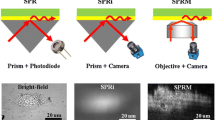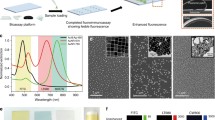Abstract
Detecting, imaging, and monitoring cell function on a single-cell basis is very important in the field of immunology research where many molecules are secreted from cells in response to external stimuli including immunization. Here, we introduce substrates with plasmonic nanoparticles and fluorescence microscopy as promising imaging methods for studies on molecular processes controlling cell behavior, particularly secretion of cytokines. We developed a unique composition of silver and silica layers of plasmonic nanostructures which resulted in fluorescence enhancement of more than 200-fold for the ensemble of molecules in the immunoassay. For the proof of concept demonstration, we used primary mouse macrophages and imaged tumor necrosis alpha secretion after stimulation of the cells with lipopolysaccharide. We demonstrate that metal-enhanced fluorescence assay provides imaging capability detection of cytokine secretion from a single cell without extensive biochemical procedures as required with standard methods. In addition, it is demonstrated that cell viability can be controlled during secretion.




Similar content being viewed by others
References
Henry, A. I., Bingham, J. M., Ringe, E., Marks, L. D., Schatz, G. C., Van Duyne, R. P. (2011). Correlated structure and optical property studies of plasmonic nanoparticles. Journal of Physical Chemistry C, 115, 9291–9305.
Luk’yanchuk, B., Zheludev, N. I., Maier, S. A., Halas, N. J., Nordlander, P., Giessen, H., Chong, C. T. (2010). The Fano resonance in plasmonic nanostructures and metamaterials. Nature Materials, 9, 707–715.
Stiles, P. L., Dieringer, J. A., Shah, N. C., Van Duyne, R. P. (2008). Surface-enhanced Raman spectroscopy. Annual Review of Analytical Chemistry, 1, 601–626.
Stewart, M. E., Anderson, C. R., Thompson, L. B., Maria, J., Grey, S. K., Rogers, J. A., Nuzzo, R. G. (2008). Nanostructured plasmonic sensors. Chemical Review, 108, 494–521.
Lakowicz, J. R., Ray, K., Chowdhury, M., Szmacinski, H., Fu, Y., Zhang, J., Nowaczyk, K. (2008). Plasmon-controlled fluorescence: a new paradigm in fluorescence spectroscopy. Analyst, 133, 1308–1346.
Fort, E., & Grésillon, S. (2008). Surface enhanced fluorescence. Journal of Physics D: Applied Physics, 41, 1–31.
Hao, Q., Qiu, T., Chu, P. K. (2012). Surface—enhanced cellular fluorescence imaging. Progress in Surface Science, 87, 23–45.
Ming, T., Chen, H., Jiang, R., Li, Q., Wang, J. (2011). Plasmon-controlled fluorescence: beyond the intensity enhancement. Journal of Physical Chemistry Letters, 3, 191–201.
Arnáiz, B., Martinez-Ávila, O., Falcon-Perez, J., Penadés, S. (2012). Cellular uptake of gold nanoparticles bearing HIV gp120 oligomannosides. Bioconjugate Chemistry, 23, 814–825.
Saha, A., Basiruddin, S. K., Sarkar, R., Pradhan, N., Jana, N. R. (2009). Functionalized plasmonic-fluorescent nanoparticles for imaging and detection. Journal of Physical Chemistry C, 113, 18492–18498.
Zhang, J., Fu, Y., Mei, Y., Jiang, F., Lakowicz, J. R. (2010). Fluorescent metal nanoshell probe to detect single miRNA in lung cancer cell. Analytical Chemistry, 82, 4464–4471.
Zhang, J., Fu, Y., Liang, D., Shao, R. Y., Lakowicz, J. R. (2009). Fluorescent avidin-bound silver particle: a strategy for single target molecule detection on a cell membrane. Analytical Chemistry, 81, 883–889.
Huang, C.-S., George, S., Lu, M., Chaudhery, V., Tan, R., Zangar, R. C., Cunningham, B. T. (2011). Application of photonic crystal enhanced fluorescence to cancer biomarker microarrays. Analytical Chemistry, 83, 1425–1430.
Chan, L. L., Gosangari, S. L., Watkin, K. L., Cunningham, B. T. (2007). A label-free photonic crystal biosensor imaging method for detection of cancer cell cytotoxicity and proliferation. Apoptosis, 12, 1061–1068.
Ballarini, M., Frascella, F., Enrico, E., Mandracci, P., De Leo, N., Michelotti, F., Giorgis, F., Descrovi, E. (2012). Bloch surface waves-controlled fluorescence emission: coupling into nanometer-sized polymeric waveguides. Applied Physics Letters, 100, 063305.
Le Moal, E., Fort, E., Lévêque-Fort, S., Cordelières, F. P., Fontaine-Aupart, M. P., Ricolleau, C. (2007). Enhanced fluorescence cell imaging with metal-coated slides. Biophysical Journal, 92, 2150–2161.
Rice, J. M., Stern, L. J., Guignon, E. F., Lawrence, D. A., Lynes, M. A. (2012). Antigen-specific T cell phenotyping microarrays using grating coupled surface plasmon resonance imaging and surface plasmon coupled emission. Biosensors and Bioelectronics, 31, 264–269.
Thorpe, R., Wadhwa, M., Page, C., Mire-Sluis, A. (1999). Biological characterization and assay of cytokines and growth factors. Development in Biological Standarization, 97, 61–71.
Moody, M. D., Van Arsdell, S. W., Murphy, K. P., Orencole, S. F., Burns, C. (2001). Array-based ELISA for high-throughput anlysis of human cytokines. Biotechniques, 31(1), 186–196.
Becher, B., Blain, M., Giacomini, P. S., Antel, J. P. (1999). Inhibition of Th1 polarization by soluble TNF receptor is dependent on antigen-presenting cell-derived IL-12. Journal of Immunology, 162, 684–688.
Ewen, C., & Baca-Estrada, M. E. (2001). Evaluation of interleukin-4 concentration by ELISA is influenced by the consumption of IL-4 by cultured cells. Journal of Interferon Research, 21, 39–43.
Barnes, A. (1998). Measurement of serum cytokines. Lancet, 352, 324–325.
Dinter, A., & Berger, E. G. (1998). Golgi-disturbing agents. Histochemistry and Cell Biology, 109, 571–590.
Asemissen, A. M., Nagorsen, D., Keilholz, U., Letsch, A., Schmittel, A., Thiel, E., Scheibenbogen, C. (2001). Flow cytometric determination of intracellular or secreted IFNγ for the quantification of antigen reactive T cells. Journal of Immunological Methods, 251, 101–108.
Tanguay, S., Killion, J. (1994). Direct comparison of ELISPOT and ELISA-based assays for detection of individual cytokine-secreting cells. Lymphokine and Cytokine Research, 13, 259–263.
Boulet, S., Ndongala, M. I., Peretz, Y., Boisvert, M. P., Boulassel, M. R., Tremblay, C., Routy, J. P., Sekaly, R. P., Bernard, N. F. (2007). A dual color ELISPOT method for the simultaneous detection of IL-2 and IFN-γ HIV-specific immune responses. Journal of Immunological Methods, 320, 18–29.
Karulin, A. Y., Hesse, M. D., Tary-Lehmann, M., Lehmann, P. V. (2000). Single-cytokine producing CD4 memory cells predominate in type 1 and type 2 immunity. Journal of Immunology, 164, 1862–1872.
Gazagne, A., Claret, E., Wijdenes, J., Yssel, H., Bousquet, F., Levy, E., Vielh, P., Scotte, F., Le Goupil, T., Fridman, W. H., Tartour, E. (2003). A Fluorospot assay to detect single T-lymphocytes simultaneously producing multiple cytokines. Journal of Immunological Methods, 283, 91–98.
Chen, D. S., Soen, Y., Stuge, T. B., Lee, P. P., Webere, J. S., Brown, P. O., Davis, M. M. (2005). Marked differences in human melanoma antigen-specific T cell responsiveness after vaccination using a functional microarray. PLoS Medicine, 2(10), e265. doi:10.1371/journal.pmed.0020265.
Shirai, A., Holmes, K., Klinman, D. M. (1993). Detection and quantitation of cells secreting IL-6 under physiological conditions in BALB/c mice. Journal of Immunology, 150, 793–799.
Szmacinski, H., Badugu, R., Lakowicz, J. R. (2010). Fabrication and characterization of planar plasmonic substrates with high fluorescence enhancement. Journal of Physical Chemistry C, 114, 21142–21149.
Szmacinski, H., Bagugu, R., Mahdavi, F., Blair, S., Lakowicz, J. R. (2012). Large fluorescence enhancements of fluorophore ensembles with multilayer plasmonic substrates: comparison of theory and experimental results. Journal of Physical Chemistry C, 116, 21563–21571.
Szmacinski, H., Murtaza, Z., Lakowicz, J. R. (2010). Time-resolved method for one-step immunoassays using plasmonic nanostructures. Journal of Physical Chemistry C, 114, 7236–7241.
Acknowledgments
This research was supported by NIH grants R21CA147975, HG005090, HG002655, and AI0082299.
Author information
Authors and Affiliations
Corresponding author
Rights and permissions
About this article
Cite this article
Szmacinski, H., Toshchakov, V., Piao, W. et al. Imaging of Protein Secretion from a Single Cell Using Plasmonic Substrates. BioNanoSci. 3, 30–36 (2013). https://doi.org/10.1007/s12668-013-0076-7
Published:
Issue Date:
DOI: https://doi.org/10.1007/s12668-013-0076-7




